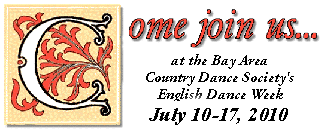
English Week 2010 Program Questionnaire
|
Unless otherwise noted, layout and content Copyright © 2002-2010, Bay Area Country Dance Society. All rights reserved.

English Week 2010 Program Questionnaire
|
Unless otherwise noted, layout and content Copyright © 2002-2010, Bay Area Country Dance Society. All rights reserved.